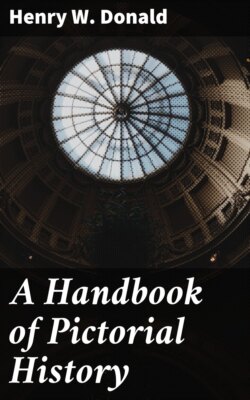Читать книгу A Handbook of Pictorial History - Henry W. Donald - Страница 20
На сайте Литреса книга снята с продажи.
NORMAN CUSTOMS.
ОглавлениеTable of Contents
The ordinary costumes of people in early Norman times differed little from that of the Saxons.
At first the Norman warriors were clean-shaven, but after settling in England the courtiers gave way to a love of finery. They wore long, embroidered garments with long white sleeves, and they allowed their hair and beards to grow long so that they incurred the reproach of the clergy, who called them “filthy goats.”
The Norman ladies also changed from the simplicity of their costume to a great extravagance of shape and material. The gowns were very ample, and were sometimes worn with a kind of train.
The general garments of the men were the tunic, the super-tunic, and the mantle.
The upper classes wore a garment next to the skin, under the tunic, called the just-au-corps; but amongst the lower classes the tunic was worn next to the skin. The Tunic was made of linen or cloth, had short sleeves, and reached at first to the knees, but later to the ground. Over this was worn a super-tunic corresponding to the Saxon tunica, with tight sleeves, reaching to the wrist, and subject to the same modification as the tunic.
The mantle was similar to the Saxon mantle, but was fuller. In later Norman times it was made of the finest cloth, and was lined with rich furs. There were several forms of cap, as illustrated in the plate. The lower limbs were covered with a kind of trousers called chausses. The shoes in early Norman times were quite plain, but later they were very elaborate, coloured, and had pointed toes.
The costume of Norman ladies consisted of a robe, a mantle, and a couvre-chef.
The robe was worn with long sleeves, and in later times with long pendulous strips at the wrists, often of such a length that they had to be tied into knots to keep them from trailing on the ground. The skirt of the robe was long, full, and hung in folds on the ground.
The mantle was worn over the robe, and the head was covered, as in Saxon times, with a head-veil, which was now called the couvre-chef.
The hair was worn plaited into two long tails. From illustrations in MSS. it is seen that the costumes of the lower classes during Norman times were similar to those worn during the three preceding centuries.
PLATE 17.
(Fig. 1): The figure of Queen Matilda, wife of Henry I. The sculptured effigies of these two sovereigns are the earliest of those of English sovereigns in existence, and are at Rochester Cathedral. They are mutilated, but still 43–44 show clearly the details of royal costume. In the figure of Matilda the hair is plaited into two tails. She wears a long robe girded at the waist and having long sleeves. Over this she wears a long mantle. (Fig. 2): Costume of a young man of the middle classes. (Representing David with a sling in Cott. MS., Nero C4.) He wears a long tunic reaching to the ankles, having a collar, long cuffs extending nearly to the elbow, and an embroidered border along the bottom. He also wears tight-fitting chausses, and the lower parts of his legs are covered either with high boots or with leg bandages. (Fig. 3): Costume of an older man. (From the same MS., representing Noah with an axe about to build the Ark.) He wears a Phrygian hat with a band around it, a long, full tunic with hanging sleeves, and a green mantle bordered with gold thrown over it. He appears to be wearing stockings reaching to the knees, and his shoes are ornamented with diagonal lines crossing each other. He has long hair and a moustache and beard. This is considered to be a good example of the ordinary costume of the time. (Figs. 4 and 5): Examples of a covering for the lower part of the leg. (From the same MS.) (Fig. 4): A swathing for the leg worn by shepherds, similar in appearance to the hay bands of the modern carter. (Fig 5): Shows a leg of the breeches ornamented with diagonal stripes ending at the ankle, where there is a band or garter. No shoes are worn, as frequently appears to have been the case when persons were on a journey. (Fig. 6): A sock or half-boot ornamented around the top. (Fig. 7): A Norman shoe with stocking. (Fig. 8): A shoe of later Norman times, decorated with bands and coloured. (Fig. 9): Pointed military shoe from a seal. (Figs. 10, 11, 12, 13): The four commonest forms of head-dress in use. (Fig. 13): Shows that called the cowl. (Fig. 14): Figure of a Norman lady showing the robe with long sleeves, the mantle, and the couvre-chef.
